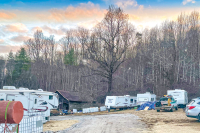A long tradition of greenery and Christmas
Christmas greenery is a Southern Appalachian specialty. This region has been furnishing the eastern United States with quantities of various evergreen materials (trees, running ground cedar, mistletoe, galax, and so on) for well over a century. Of these, one of the most interesting is holly. In many ways, this plant’s dark green leaves and scarlet red berries signify Christmas almost as much as the Christmas tree itself.
Here in Western North Carolina there are three holly species, belonging to the genus “Ilex” (pronounced “ee-lexs”). Two of these, winterberry and mountain holly, bear clusters of scarlet berries that make a colorful show in winter but do not have evergreen leaves.
Christmas or American holly (I. opaca) is easily identified by its spiny, wavy-edged, glossy, evergreen leaves borne on alternating stems. Each leaf persists for about three years before being shed in the spring. The light gray bark is often roughened by wart-like growths.
In WNC, Christmas holly is a relatively uncommon tree found in rich bottomlands, cove hardwoods, and hemlock forests. Mature trees tend to form a pyramidal shape with a narrow crown. Specimens of up to four feet in diameter have been reported from the rich bottomlands of Texas and Arkansas, but in our region a holly with a diameter of two feet is good-sized.
You will have undoubtedly noticed that most holly trees do not bear berries, which are usually red but may be yellowish. This is because the “male” trees bear staminate flowers that produce pollen, while the “female” trees bear pistillate flowers and produce fruit. Many plants (willow, sassafras, persimmon, mulberry, etc.) have evolved this method of producing pollen and seed-bearing flowers on separate individuals in order to effectively insure cross-fertilization.
Before Christmas-green pickers began mindlessly harvesting the leaves and berry clusters from female hollies, there was no doubt a more even distribution of the sexes. But the habit of tearing off the berry-laden branches has resulted in the obvious depletion of the female type, while over the course of time necessarily reducing the entire population.
If you choose to harvest holly sprigs, do so with discretion, taking care to saw the stem off neatly rather than haphazardly tearing off armfuls and thereby exposing the tree to disease and death. Also keep in mind that sprigs can be sprayed with a clear shellacking agent and used from one season to next.
I’ve never been tempted to try them, but holly berries are reported to be noxious to humans. Indeed, the coastal holly named yaupon (I. vomitoria) was harvested by the Indians and brewed so as to produce a bitter and powerful tea called “The Black Draught,” which used as a ceremonial purgative.
The ongoing custom of employing evergreen plants for decorative purposes during the Christmas season is obviously one of considerable antiquity, apparently originating in pre-Christian ceremonies that celebrated the winter solstice. It’s variously dated as a survival of the licentious Roman Saturnalia (held about Dec. 17) or more directly to the old Teutonic practice of festooning the interior of dwellings with evergreens as a way of providing a refuge for sylvan spirits so as to allow them to survive the winter gloom.
In time, our immediate ancestors — who were not for the most part inclined toward unrestrained revels or a belief in woodland spirits — exchanged holly’s bright fruits and shiny leaves as a token of friendship to help cheer up homes at a time of the year when daylight was at its shortest and as an emblem of the Christmas season. In this manner, the annual rite of decorating with holly — rooted in an awareness of the solar cycle and the rebirth of light — has been carried over into the celebration of the Nativity.
George Ellison wrote the biographical introductions for the reissues of two Appalachian classics: Horace Kephart’s Our Southern Highlanders and James Mooney’s History, Myths, and Sacred Formulas of the Cherokees. In June 2005, a selection of his Back Then columns was published by The History Press in Charleston as Mountain Passages: Natural and Cultural History of Western North Carolina and the Great Smoky Mountains. Readers can contact him at P.O. Box 1262, Bryson City, N.C., 28713, or at This email address is being protected from spambots. You need JavaScript enabled to view it..





